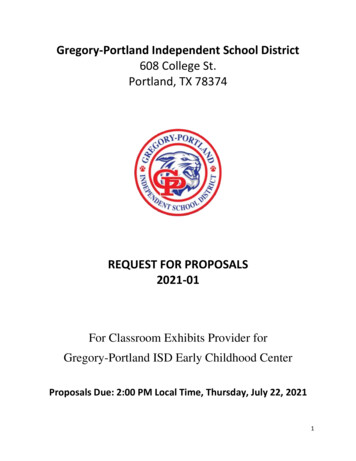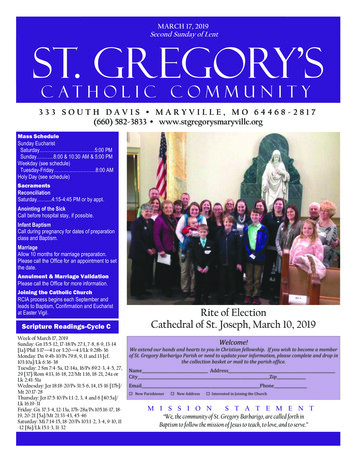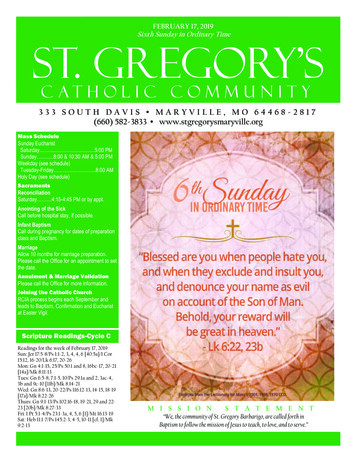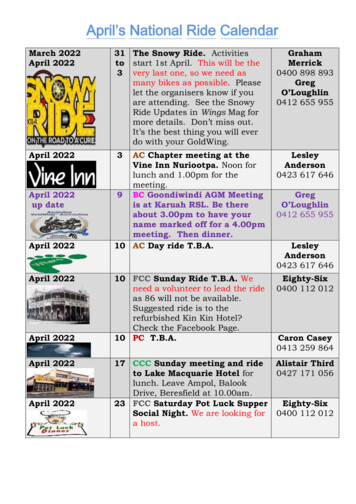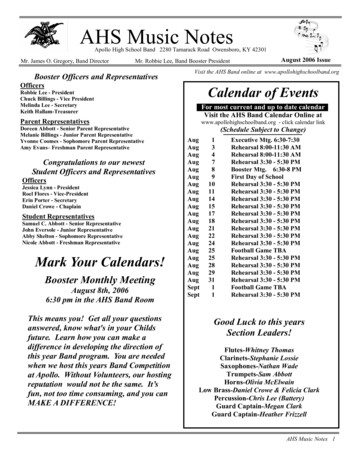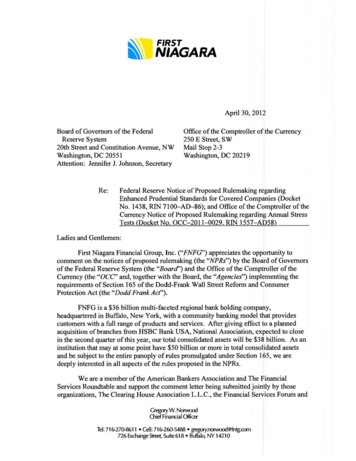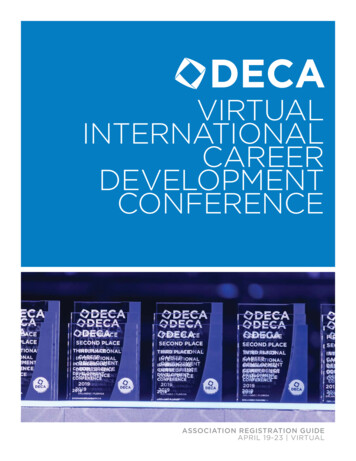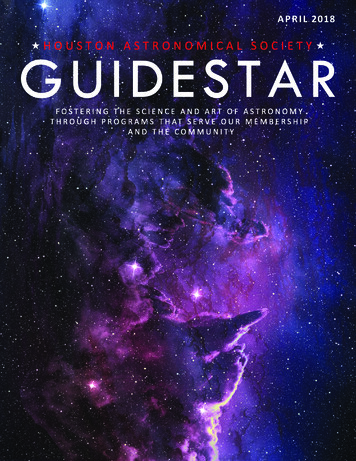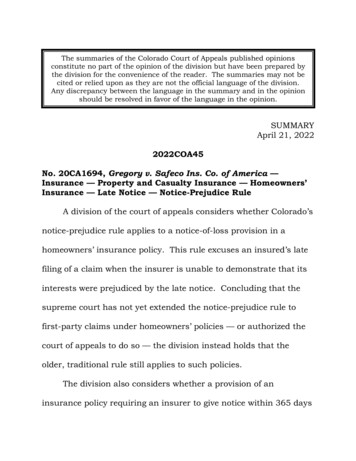
Transcription
The summaries of the Colorado Court of Appeals published opinionsconstitute no part of the opinion of the division but have been prepared bythe division for the convenience of the reader. The summaries may not becited or relied upon as they are not the official language of the division.Any discrepancy between the language in the summary and in the opinionshould be resolved in favor of the language in the opinion.SUMMARYApril 21, 20222022COA45No. 20CA1694, Gregory v. Safeco Ins. Co. of America —Insurance — Property and Casualty Insurance — Homeowners’Insurance — Late Notice — Notice-Prejudice RuleA division of the court of appeals considers whether Colorado’snotice-prejudice rule applies to a notice-of-loss provision in ahomeowners’ insurance policy. This rule excuses an insured’s latefiling of a claim when the insurer is unable to demonstrate that itsinterests were prejudiced by the late notice. Concluding that thesupreme court has not yet extended the notice-prejudice rule tofirst-party claims under homeowners’ policies — or authorized thecourt of appeals to do so — the division instead holds that theolder, traditional rule still applies to such policies.The division also considers whether a provision of aninsurance policy requiring an insurer to give notice within 365 days
of a covered loss is invalid under section 10-4-110.8(12)(a), C.R.S.2021, of the Colorado Homeowner’s Reform Act of 2013. Thisprovision provides that homeowners may still file suit against theirinsurer within the applicable statute of limitations notwithstandingany provision in their insurance policy that requires homeowners tofile suit within a shorter time period. The division concludes thatthe 365-day notice provision in question does not contravene thisstatute.
COLORADO COURT OF APPEALS2022COA45Court of Appeals No. 20CA1694City and County of Denver District Court No. 19CV34856Honorable Michael A. Martinez, JudgeKaryn Gregory,Plaintiff-Appellant,v.Safeco Insurance Company of America,Defendant-Appellee.JUDGMENT AFFIRMEDDivision IIOpinion by JUDGE KUHNFurman and Pawar, JJ., concurAnnounced April 21, 2022Roth Milne, David Roth, Jennifer A. Milne, Denver, Colorado, for PlaintiffAppellantLewis Roca Rothgerber Christie LLP, Brian J. Spano, Holly C. White, AuroraTemple Barnes, Denver, Colorado, for Defendant-AppelleeMoGo LLC, Rodney J. Monheit, Katherine E. Goodrich, Denver, Colorado, forAmicus Curiae Colorado Trial Lawyers AssociationWaltz Reeves, Christopher R. Reeves, Denver, Colorado, for Amicus CuriaeColorado Defense Lawyers Association
¶1In this late-notice insurance coverage dispute, Karyn Gregorybrought suit against her insurer, Safeco Insurance Company ofAmerica, after Safeco denied her first-party insurance claim forproperty damage as untimely under her homeowners’ insurancepolicy. Gregory appeals the district court’s grant of summaryjudgment to Safeco rejecting the applicability of Colorado’s noticeprejudice rule to policies like hers.¶2Our appellate courts have not yet considered this issue, andthere appears to be uncertainty surrounding it in federal courtsapplying Colorado law. Gregory asks us to resolve this uncertainty.We conclude that only the supreme court may decide whether toreplace the traditional rule with the notice-prejudice rule for firstparty claims under homeowners’ insurance policies. We thereforeaffirm the judgment of dismissal, but we note that this case maypresent an opportunity for our supreme court to provide clarity onthis question.I.¶3BackgroundThe facts of this case are undisputed. Gregory procured ahomeowners’ insurance policy (the Policy) from Safeco that coveredspecified direct physical damage to her home that “occurs during1
the policy period.” The Policy ran from February 15, 2017, toFebruary 15, 2018, and in May 2017, a hailstorm damagedGregory’s roof — a type of loss covered under the Policy.¶4But Gregory did not notify Safeco or file a claim for the lossuntil roughly eighteen months later, shortly after a contractorinformed her of the hail damage. Safeco did not initially investigatethe damage to Gregory’s home, but its initial review determined thatthe May 2017 hailstorm was the most recent one to occur nearGregory’s property.1 Based on this determination, Safecosummarily denied her claim as untimely, citing the eighteen-monthdelay and a notice provision in the Policy specific to hail damage:In case of a loss to which this insurance mayapply, you must perform the following duties:.give immediate notice to us or our agent. Withrespect to loss caused by the peril of . . . Hail,Safeco did not inspect the damage to Gregory’s roof until after shefiled suit in December 2019. Gregory filed an affidavit by a licensedpublic adjuster who inspected her home in February 2020 — morethan thirty-three months after the hailstorm. He believed her roofhad visible and prevalent hail damage from the May 2017 hailstormthat could still have been inspected more than a year after thedamage occurred.12
the notice must be within 365 days after thedate of the loss . . . .Under the same section, the Policy provides that “[n]o action shallbe brought against [Safeco] unless there has been compliance withthe policy provisions . . . .” And at the very beginning of the Policy,it states that Safeco “will pay claims and provide coverage asdescribed in this policy if [Gregory] . . . compl[ies] with all theapplicable provisions outlined in this policy.”¶5More than two years after Safeco denied her claim, Gregoryfiled suit, claiming that Safeco’s denial was a breach of contract anda bad-faith breach of an insurance policy, and that Safecounreasonably delayed and denied payment of her claim undersections 10-3-1115 and -1116, C.R.S. 2021.¶6Safeco filed a motion for summary judgment under C.R.C.P.56(b), and Gregory responded with a motion for determination of aquestion of law under C.R.C.P. 56(h). Both motions addressed thesame two issues Gregory appeals here:(1)whether Colorado’s notice-prejudice rule applies, whichwould require Safeco to demonstrate it was prejudiced by3
Gregory’s late notice before denying her benefits for anuntimely claim; and(2)whether the Policy’s 365-day notice provision is invalidunder section 10-4-110.8(12)(a), C.R.S. 2021, whichlimits insurers’ ability to contractually shorten theapplicable statute of limitations for insureds to file suitslike Gregory’s against them.¶7The district court ruled in favor of Safeco. It concluded thatthe 365-day notice requirement did not contravene the statute-oflimitations provision, that Gregory’s claim was untimely under theplain terms of the Policy, that her delay was unexcused as a matterof law, and that Safeco was therefore relieved of its obligation toprovide coverage benefits for her claim.¶8In so concluding, the court reasoned that the supreme courthas not extended Colorado’s notice-prejudice rule to first-partyclaims under homeowners’ insurance policies like Gregory’s, and, inthis absence, the supreme court’s precedent regarding the“traditional approach” required the court to strictly apply Gregory’sfailure to abide by the Policy’s notice provision against her. The4
court thus determined it did not need to reach the question ofwhether Safeco was prejudiced by Gregory’s late notice.II.¶9AnalysisWe review the court’s order granting summary judgment denovo. MarkWest Energy Partners, L.P. v. Zurich Am. Ins. Co., 2016COA 110, ¶ 11. Summary judgment is proper if there is no genuineissue as to any material fact and Safeco is entitled to judgment as amatter of law. Id.¶ 10We agree with the district court on both issues and thereforeconclude that the court properly granted summary judgment toSafeco.A.¶ 11Notice-Prejudice RuleGregory does not contend that the terms of the Policy doanything other than unambiguously bar coverage benefits for ahail-damage claim unless she provides notice to Safeco within 365days of her loss. Travelers Prop. Cas. Co. v. Stresscon Corp., 2016CO 22M, ¶ 12 (“[A]n insurance policy is a contract, theunambiguous terms of which must be enforced as written . . . .”).Nor does she contend that her delay in giving notice of her claimwas justified. E.g., Clementi v. Nationwide Mut. Fire Ins. Co., 165
P.3d 223, 226-27 (Colo. 2001) (recognizing that, in certaincircumstances, an insured may be excused for untimely notice iftheir delay in giving notice was justified).¶ 12Instead, Gregory argues the district court erred by notapplying Colorado’s notice-prejudice rule to the notice-of-lossprovision in her homeowners’ insurance policy. This rule “allow[s]insureds to avoid strict enforcement of a notice provision for publicpolicy reasons.” Craft v. Phila. Indem. Ins. Co., 2015 CO 11, ¶ 34.Under it, “an insured who gives late notice of a claim to his or herinsurer does not lose coverage benefits unless the insurer proves bya preponderance of the evidence that the late notice prejudiced itsinterests.” Id. at ¶ 2. If the insurer cannot show prejudice, theinsured is “excuse[d] . . . from fulfilling a straightforwardcontractual condition — the notice requirement.” Id. at ¶ 39.¶ 13The supreme court has applied the notice-prejudice rule tonotice provisions in underinsured motorist (UIM) andcomprehensive general liability insurance policies. Clementi, 16P.3d at 224 (UIM policy); Friedland v. Travelers Indem. Co., 105 P.3d639, 641-42 (Colo. 2005) (liability policy). Gregory acknowledgesthat no Colorado court has explicitly applied this rule to6
homeowners’ policies like hers. Nonetheless, she argues that —regardless of the type of insurance policy involved — supreme courtprecedent allows us to extend this rule to new types of coverage ifwe are satisfied by the public policy considerations enumerated inClementi.¶ 14We disagree. We note the supreme court’s acknowledgementof the “modern trend” to extend the notice-prejudice rule to latenotice cases, Clementi, 16 P.3d at 229-30, but the court has beencareful in applying and extending the rule — and indeed in theassociated weighing of public policy considerations. In our view,applying the notice-prejudice rule to an entirely new class ofinsurance policies would still require departure from our supremecourt’s precedent, an undertaking exclusively reserved to thatcourt. See People v. Novotny, 2014 CO 18, ¶ 26. For this reason,we conclude the district court properly applied Colorado’straditional approach to Gregory’s late-filed insurance claim.1.¶ 15The Backdrop: Colorado’s Traditional ApproachTraditionally, Colorado courts did not consider insurerprejudice in late-notice cases, no matter the type of insurancepolicy involved. See Clementi, 16 P.3d at 226. Rather, Colorado law7
has held that “an unexcused delay in giving notice relieves theinsurer of its obligations under an insurance policy, regardless ofwhether the insurer was prejudiced by the delay.” Id. at 227. Thistraditional approach is “grounded upon a strict contractualinterpretation of insurance policies under which delayed notice wasviewed as constituting a breach of contract, making the issue ofinsurer prejudice immaterial.” Id. at 226.¶ 16Yet, the traditional approach did not leave an insured withoutrecourse in all circumstances when their insurer denied a late claimas untimely. Rather, Colorado law held that an insured could beexcused for a delay in providing notice if the insured demonstrated“justifiable excuse or extenuating circumstances explaining thedelay.” E.g., Certified Indem. Co. v. Thun, 165 Colo. 354, 360, 439P.2d 28, 30 (1968).¶ 17Colorado adhered to the traditional approach for nearly acentury following the supreme court’s landmark 1909 case, Barclayv. London Guarantee & Accident Co., 46 Colo. 558, 105 P. 865(1909). Marez v. Dairyland Ins. Co., 638 P.2d 286, 288-89 (Colo.1981) (collecting cases and tracing the traditional approach toBarclay), overruled in part by Friedland, 105 P.3d 639. Indeed,8
since Barclay, Colorado courts have applied the traditionalapproach to notice provisions for first-party claims under insurancepolicies covering property and other personal loss. See CapitolFixture & Supply Co. v. Nat’l Fire Ins. Co., 279 P.2d 435, 437 (Colo.1955) (fire insurance policy for late proof of loss); Circle C Beef Co. v.Home Ins. Co., 654 P.2d 869, 870 (Colo. App. 1982) (fire insurancepolicy for late proof of loss); Jennings v. Bhd. Accident Co., 44 Colo.68, 73-76, 96 P. 982, 984 (1908) (disability insurance policy for lateproof of loss); Ord. of United Com. Travelers v. Boaz, 27 Colo. App.423, 425-28, 150 P. 822, 824 (1915) (accidental death insurancepolicy for late notice of loss), rev’d on other grounds, 69 Colo. 44,168 P. 1178 (1917); see also Conn. Fire Ins. Co. v. Colo. Leasing,Min. & Milling Co., 50 Colo. 424, 435-43, 116 P. 154, 160 (1911)(refusing to apply traditional approach to notice-of-loss provision infire insurance policy based on court’s conclusion that the policy atissue did not make timely notice a condition precedent to coverage);Preferred Accident Ins. Co. v. Fielding, 35 Colo. 19, 22-28, 83 P.1013, 1015-16 (1905) (same outcome for notice-of-loss provision inaccidental injury insurance case).9
¶ 18In the 1981 case Marez v. Dairyland Insurance Co., thesupreme court considered for the first time whether to abandon thetraditional approach and adopt the notice-prejudice rule in thecontext of an automobile liability insurance case in which theinsured failed to provide any notice to his insurer of an otherwisecovered liability claim made against him. 638 P.2d at 290. In thisno-notice context, the supreme court concluded that the “salutarypurposes of the notice provisions should not be set aside withoutsubstantial justification,” and the insured’s complete lack of notice“did not provide a factual context compelling a departure from thetraditional approach.” Clementi, 16 P.3d at 227 (citing Marez, 638P.2d at 290-91). The court thus “refused to depart” from theapproach it traced back to Barclay, id., concluding that theinsured’s failure to abide by the policy’s notice provisionconstituted, as a matter of law, a breach of the policy relieving theinsurer of its obligation to cover the claim, Marez, 638 P.2d at 286,288-89.¶ 19Gregory contends that, though the traditional approach wasalive and well in Colorado going into the twenty-first century, thesupreme court’s modern precedent permits this court to reject the10
traditional approach’s application to her first-party claim under ahomeowners’ insurance policy.2.¶ 20Modern Cases: Adopting Notice-Prejudicein Limited CircumstancesIn 2001, the supreme court in Clementi again reviewedwhether to abandon the traditional approach — this time in thecontext of a late-notice case under a UIM insurance policy. 16 P.3dat 224-25. In its analysis, the court observed that it “ha[d] notpreviously considered whether the notice-prejudice rule applies inUIM cases,” and that the modern trend in the majority of states hasbeen to apply the notice-prejudice rule “in the context of a UIMcase.” Id. at 225, 228. The court decided to bring Colorado in linewith that modern trend and “expressly adopt the notice-prejudicerule in Colorado, as it applies to UIM cases.” Id. at 232.¶ 21To get to this ruling, Clementi distinguished Marez, concludingthat “because Marez involved a no-notice liability case, we find thatMarez is inapplicable in determining whether insurer prejudiceshould be considered in the UIM late-notice case at bar.” Id. at228; see also Friedland, 105 P.3d at 644 n.2. Clementi, in other11
words, “limited [itself] to the particular context of [its] case, a UIMpolicy.” Friedland, 105 P.3d at 645.¶ 22In support of its adoption of the notice-prejudice rule for late-notice UIM cases, Clementi identified three public policies that otherstates had offered for justifying a departure from the traditionalapproach: (1) the adhesive nature of UIM insurance contracts,(2) the public policy objective of compensating innocent tort victims,and (3) the inequity of the insurer reaping a windfall by invoking atechnicality to deny coverage. Clementi, 16 P.3d at 229; see alsoCraft, ¶ 26. Reasoning that all three policy justifications had beenrecognized in Colorado law — at least in the particular context ofUIM insurance — the court adopted the notice-prejudice rule forUIM policies, concluding that “insurer prejudice should now beconsidered when determining whether noncompliance with a UIMpolicy’s notice requirements vitiates coverage.” Clementi, 16 P.3d at229-30.¶ 23Five years later, the supreme court in Friedland again revisitedthe notice-prejudice rule in a late-notice liability case, grantingcertiorari “to determine whether the notice-prejudice ruleannounced in Clementi . . . applies to liability policies” and12
answering that question in the affirmative. Friedland, 105 P.3d at641.¶ 24The parties in Friedland argued whether Clementi’s adoption ofthe notice-prejudice rule should be limited to UIM cases. Id. at 644n.2. The court recognized a trend in other states to apply this ruleto liability policies, and again it reasoned that the same publicpolicy justifications outlined in Clementi — this time analyzed in theliability insurance context — supported the extension of the noticeprejudice rule to liability policies. Id. at 646-47; see also Marez,638 P.2d at 293 (Quinn, J., dissenting) (analyzing public policies inautomobile liability context). In so ruling, the supreme court“overrule[d] Marez to the extent it applies to late-notice liabilitycases.” Friedland, 105 P.3d at 643, 645.¶ 25Ten years later, the supreme court again revisited the notice-prejudice rule in two liability insurance cases — Craft andStresscon. In Craft, the supreme court declined to extend thenotice-prejudice rule to a date-certain notice requirement in a“claims-made” policy — that is, a policy which “covers only thoseclaims brought against the insured during the policy period andreported to the insurer by a date certain, typically within a brief13
window following expiration of the policy period.”2 Craft, ¶¶ 3, 4, 7,32. And in Stresscon, the supreme court again declined to extendthe rule to a different type of policy provision — a “no voluntarypayments” clause that excluded from coverage certain payments theinsured voluntarily made to a tort victim without the consent oftheir insurer. Stresscon, ¶¶ 2-3, 23.¶ 26In both cases, the supreme court noted that it had notpreviously addressed whether the notice-prejudice rule shouldapply in these contexts. Craft, ¶ 2; see Stresscon, ¶¶ 17-21. Andfor each context, the court reasoned that the public policiesrecognized in Clementi did not support the extension of the rule.Craft, ¶¶ 7, 43-45; Stresscon, ¶¶ 11-15.3.¶ 27The Traditional Approach StillApplies to Gregory’s PolicyGregory contends that the Clementi line of cases requires us todetermine if the public policies recognized in Clementi supportextension of the notice-prejudice rule to policies like hers. AmicusThe court distinguished Friedland as involving an occurrenceliability policy as opposed to a claims-made liability policy. Craft v.Phila. Indem. Ins. Co., 2015 CO 11, ¶¶ 40-45. Gregory’s policycovered losses occurring during, not claims made in, the policyperiod.214
in support of Gregory argues that this line of cases establishesnotice-prejudice as the default rule in late-notice cases that appliesunless the Clementi policies are not satisfied.¶ 28We disagree with both readings of these cases. We see thesupreme court as taking a case-by-case approach that extends thenotice-prejudice rule to only the particular type of insurance policybefore it. Cf. Stresscon, ¶¶ 8-9 (Clementi and Friedland’s noticeholdings “did not . . . also implicitly extend our newly mintednotice-prejudice rule to no-voluntary-payments or consent-to-settleprovisions.”). The supreme court has not yet unequivocally appliedthe notice-prejudice rule to all late-notice cases.¶ 29To the contrary, it has specifically limited its notice-prejudiceholdings to UIM and liability insurance policies. In Clementi andFriedland, it expressly said so. Craft, ¶ 21 (“Although we limitedour holding in Clementi to late notice in the UIM context, ouranalysis in that case laid the groundwork for our later decision inFriedland.”); Friedland, 105 P.3d at 643 (“In this case, we apply thenotice-prejudice rule to liability policies.”). Moreover, both casesexplicitly relied on public policy justifications specific to UIM andliability policies, respectively. Craft even noted on multiple15
occasions that Clementi first adopted the notice-prejudice rule “forUIM cases” and Friedland later “extended” it to liability policies.Craft, ¶¶ 7, 16, 23, 25, 26.¶ 30Against the historical backdrop of the traditional approach inColorado, these limited holdings — and their treatment of Marez inparticular — do not persuade us that the court has implicitlyoverruled its traditional approach for all insurance policies. Asnoted, Friedland overruled Marez “to the extent it applies tolate-notice liability cases.” Friedland, 105 P.3d at 643, 645. And inClementi, the court distinguished Marez on the basis that Clementiinvolved a UIM rather than liability policy. Id. at 645. Together,these cases show that the court cabined Marez’s refusal to departfrom the traditional approach to the no-notice liability context —not the no-notice context for any type of insurance policy.3 In anyWhile the supreme court in Clementi explicitly disapproved of thiscourt’s extension of Marez to “non-liability late-notice cases,” thisstatement came in the context of the supreme court’s discussion ofthis court’s application of Marez to both UIM and liability policies.Clementi v. Nationwide Mut. Fire Ins. Co., 16 P.3d 223, 227-28 & n.5(Colo. 2001) (citing court of appeals cases applying Marez to UIMpolicies). In this context, we do not read “non-liability” to mean “alltypes of policies that aren’t liability policies” but rather only thetype before the Clementi court — a UIM policy. See Friedland v.Travelers Indem. Co., 105 P.3d 639, 644 n.2 (Colo. 2005) (“We316
event, Marez didn’t announce the traditional approach; it merelyapplied it. Id.; Marez, 638 P.2d at 286, 288. We thus disagree thatthe supreme court has jettisoned the traditional approach for allbut no-notice cases.¶ 31Further, contrary to Gregory’s assertion, this court has neverruled that the supreme court has given us authority to use theClementi justifications to extend the reach of the notice-prejudicerule to policies other than liability or UIM. In MarkWest, on whichGregory relies for this assertion, the division held that “Colorado’snotice-prejudice rule applies even where . . . the notice requirementis a condition precedent to coverage under an occurrence liabilitypolicy.” MarkWest, ¶ 31. But to reach this conclusion, MarkWestdid not analyze or otherwise rely on the Clementi policies, and,notably, MarkWest involved the same type of policy as that inFriedland. See id. at ¶¶ 16, 21-31. Additionally, the supreme courthas seemingly disapproved of this court using the Clementi policiesrecognize that [Clementi] might be read as reaffirming the Marezrule as to all cases other than UIM cases. We clarify that we did notintend to make a holding to this effect; rather, we weredistinguishing Marez at that time and chose to leave the potentialapplicability of our Clementi rationale to a liability policy case tosome future time.”).17
to extend the notice-prejudice rule to new types of provisions inUIM and liability policies. Compare Lauric v. USAA Cas. Ins. Co.,209 P.3d 190, 193 (Colo. App. 2009) (“Although the decision inClementi involved a late notice of claim, we conclude that thesupreme court, as evidenced by the decision in Friedland and itsdisapproval of the Hawkeye decision in Clementi, would apply thenotice-prejudice rule to an insured's failure to notify the insurer of,and obtain its consent to, a settlement with a tortfeasor in a UIMcase.”), with Stresscon, ¶¶ 8-9 (“We did not [in Friedland] alsoimplicitly extend our newly minted notice-prejudice rule to novoluntary-payments or consent-to-settle provisions.”).¶ 32In our view, given its decision to carefully circumscribe itsholdings rather than announce a broad rule, the supreme court hasnot yet indicated that the notice-prejudice rule should apply to alltypes of insurance policies. We therefore conclude that the task ofdeciding whether to extend the notice-prejudice rule to a new typeof insurance policy is not one we may undertake.¶ 33In concluding this, we note that federal district courtsapplying Colorado law have split, under facts nearly identical tothose here, on whether the notice-prejudice rule applies to first18
party claims under homeowners’ insurance policies. CompareCherry Grove E. II Condo. Ass’n v. Phila. Indem. Ins. Co., No.16-cv-02687-CMA-KHR, 2017 WL 6945038, at *4-5 (D. Colo. Dec.20, 2017) (in late-notice hail-damage case, concluding the Clementipolicy justifications do not support extension of the notice-prejudicerule to “first-party insurance coverage”), with Hiland HillsTownhouse Owners Ass’n v. Owners Ins. Co., No. 17-cv-1773-MSKMEH, 2018 WL 4537192, at *4-6 (D. Colo. Sept. 20, 2018)(concluding the opposite). But even Hiland Hills seemed torecognize that its conclusion might not be based on controllingColorado precedent, but rather on a prediction about what thesupreme court would do with its existing precedent if faced withthis issue. See Hiland Hills, 2018 WL 4537192, at *6 (“[T]o theextent that Friedland does not already control the outcome here,this Court is persuaded that the Colorado Supreme Court’s analysisin that case would yield the conclusion that the notice/prejudicerule is applicable in the first-party casualty insurance context aswell.”); see also Rocky Mountain Prestress, LLC v. Liberty Mut. FireIns. Co., 960 F.3d 1255, 1259 (10th Cir. 2020) (when Colorado lawhas not addressed a specific issue, the federal court will predict19
what the Colorado supreme court would hold). And, while bothcases analyzed the Clementi policy justifications to reach theirrespective conclusions, a third federal case concluded that evenundertaking this Clementi analysis would be improper, as it wouldbe premised on a prediction that the supreme court would overruleits existing precedent with respect to the traditional approach. 656Logan St. Condo. Ass’n v. Owners Ins. Co., 389 F. Supp. 3d 946,952-56 (D. Colo. 2019); see also 6 W. Apartments, LLC v. Ohio Cas.Ins. Co., No. 1:20-cv-02243-RBJ, 2021 WL 4949154, at *7 (D. Colo.Oct. 25, 2021) (agreeing with the analysis in 656 Logan Street andstating that “[t]he cases establishing notice-prejudice regimes forsome insurance contracts contain policy justifications and broadlanguage that makes their applicability to other insurance regimesunclear”).¶ 34We also acknowledge that the supreme court has, at times,spoken more broadly about the implications of its holdings inClementi and Friedland. See Stresscon, ¶ 24 (Márquez, J.,dissenting) (“[O]ur own precedent recogniz[es] that, where aprovision of an insurance contract does not fundamentally definethe scope of coverage, but instead protects the insurer’s opportunity20
to investigate and defend or settle claims, the insured’s violation ofthat provision should not present an absolute bar to recovery.”);Friedland, 105 P.3d at 645 (“Because of its reasoning and departurefrom the Barclay and Marez line of cases in favor of the noticeprejudice rule adopted by the majority of jurisdictions throughoutthe United States, we find that Clementi, not Marez, is theapplicable stare decisis precedent.”); Friedland, 105 P.3d at 647(“[W]e recognize that our decision today leaves little, if any, vitalityto Marez because disputes will likely arise only in the context of latenotice by an insured . . . .”). Moreover, at least two states that haveconsidered this issue have extended the notice-prejudice rule tonotice provisions for first-party claims for coverage. Pitzer Coll. v.Indian Harbor Ins. Co., 447 P.3d 669 (Cal. 2019) (notice-of-lossprovision in policy covering remediation for discovered pollutionconditions); Estate of Gleason v. Cent. United Life Ins. Co., 2015 MT140, 350 P.3d 349 (notice-of-loss provision in cancer benefitinsurance policy); see also Ridglea Estate Condo. Ass’n v. LexingtonIns. Co., 415 F.3d 474, 479-80 (5th Cir. 2005) (predicting thatTexas law would apply the notice-prejudice rule to notice-of-lossprovision in property insurance policy); but see GuideOne Mut. Ins.21
Co. v. First Baptist Church of Brownfield, 495 F. Supp. 3d 428,435-37 (N.D. Tex. 2020) (predicting that Texas law would not applythe notice-prejudice rule to proof-of-loss provision in propertyinsurance policy).¶ 35But fundamentally, the purpose of the notice-prejudice rule isto allow the insured to avoid a forfeiture for reasons of publicpolicy.4 Craft, ¶ 34. And in Clementi and Friedland, the supremecourt concluded that such reasons warranted the extension of therule to the insurance policies before it. But the traditionalapproach itself serves its own public policies — policies that mightcounsel in favor of forfeiture in this instance. E.g., id. at ¶ 35;Marez, 638 P.2d at 291; Stresscon, ¶ 12. Gregory, in essence, asksus to predict that the supreme court would conclude that the publicpolicies it identified in Clementi would override the policies it hasidentified as underpinning the traditional approach.¶ 36For her part, Gregory argues that the three Clementi policyjustifications provide good reasons for extending the notice-We note that, ordinarily, this court may examine whether aprovision of an insurance contract is void as against public policy.But “the notice-prejudice rule does not render a notice provisionvoid,” but rather only excuses late notice. Craft, ¶ 34.422
prejudice rule to her policy. See Friedland, 105 P.3d at 645 (“Wehave a heightened responsibility to scrutinize insurance po
No. 20CA1694, Gregory v. Safeco Ins. Co. of America — Insurance — Property and Casualty Insurance — Homeowners' Insurance — Late Notice — Notice-Prejudice Rule A division of the court of appeals considers whether Colorado's notice-prejudice rule applies to a notice-of-loss provision in a homeowners' insurance policy.
